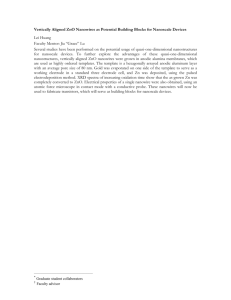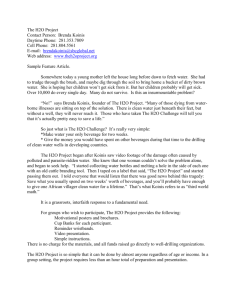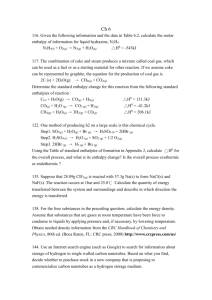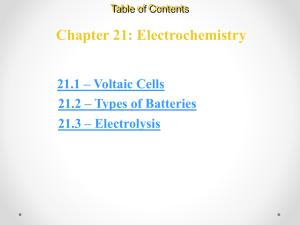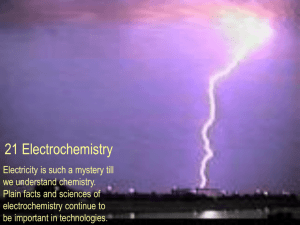Electrochemistry Worksheet II
advertisement
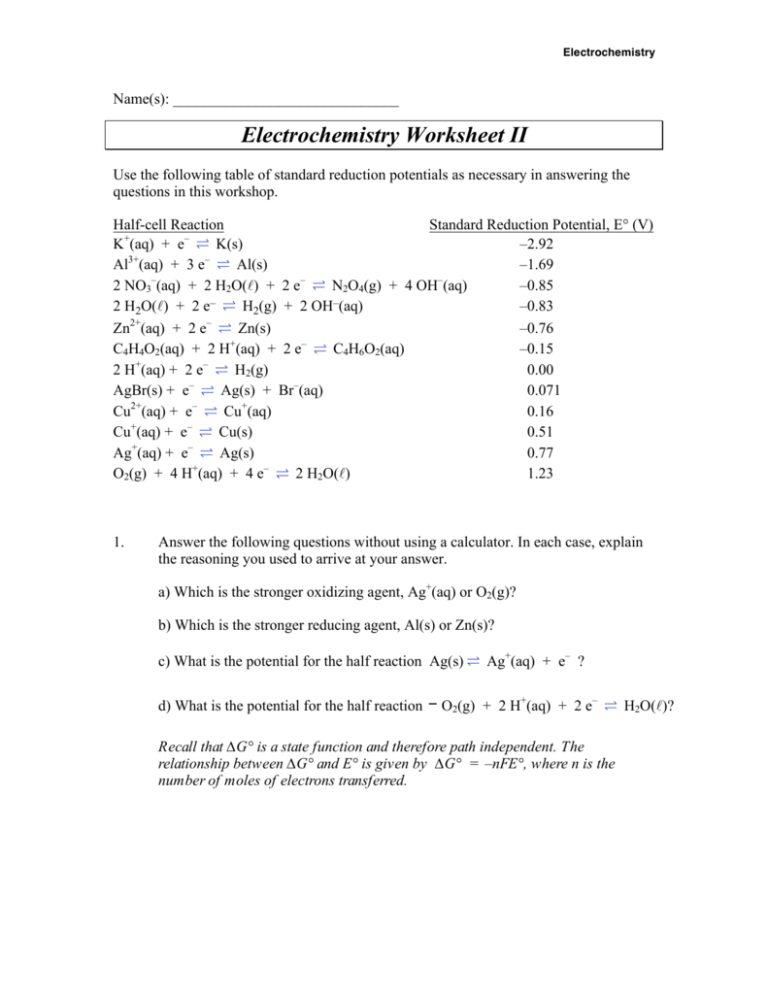
Electrochemistry Name(s): ______________________________ Electrochemistry Worksheet II Use the following table of standard reduction potentials as necessary in answering the questions in this workshop. Half-cell Reaction Standard Reduction Potential, E° (V) + – K (aq) + e K(s) –2.92 3+ – Al (aq) + 3 e Al(s) –1.69 – – – 2 NO3 (aq) + 2 H2O() + 2 e N2O4(g) + 4 OH (aq) –0.85 2 H2O() + 2 e– H2(g) + 2 OH–(aq) –0.83 2+ – Zn (aq) + 2 e Zn(s) –0.76 + – C4H4O2(aq) + 2 H (aq) + 2 e C4H6O2(aq) –0.15 + – 2 H (aq) + 2 e H2(g) 0.00 – – AgBr(s) + e Ag(s) + Br (aq) 0.071 2+ – + Cu (aq) + e Cu (aq) 0.16 + – Cu (aq) + e Cu(s) 0.51 + – Ag (aq) + e Ag(s) 0.77 + – O2(g) + 4 H (aq) + 4 e 2 H2O() 1.23 1. Answer the following questions without using a calculator. In each case, explain the reasoning you used to arrive at your answer. a) Which is the stronger oxidizing agent, Ag+(aq) or O2(g)? b) Which is the stronger reducing agent, Al(s) or Zn(s)? c) What is the potential for the half reaction Ag(s) d) What is the potential for the half reaction Ag+(aq) + e– ? O2(g) + 2 H+(aq) + 2 e– Recall that ∆G° is a state function and therefore path independent. The relationship between ∆G° and E° is given by ∆G° = –nFE°, where n is the number of moles of electrons transferred. H2O()? Electrochemistry 2. Given two half reactions with potentials E°1 and E°2, ∆G°1 + ∆G°2 = –nFE°1 – nFE°2 a) What is the free energy change for the reduction of 0.50 mol of oxygen? for 1.00 mol of oxygen? b) Determine the potential and the free energy change for the following reactions: i) solid silver and aqueous hydrogen ion ii) liquid water and potassium metal iii) aqueous hydrogen ion and potassium metal c) Will zinc metal spontaneously react with either water or 1.00 M HCl? Explain. 3. a) Write the Nernst equation expression for the reaction of Cu2+(aq) in the cathodic cell and Ni2+(aq) in the anodic cell. b) What is the potential of a cell with 0.10 M Cu2+(aq) in the cathodic cell and 0.010 M Ni2+(aq) in the anodic cell? 4. Write the Nernst equation for the reaction Ag(s) + AgBr(s) Ag+(aq) + Br–(aq). 5. When the potential for a cell is zero, there is no net tendency for electrons to flow. At equilibrium, the Nernst equation becomes 0 = E° – 0.0592 n log Keq a) Why is Keq used in place of the reaction quotient? b) Determine the value of the equilibrium constant for the reaction of potassium metal and water. c) Calculate the equilibrium constant for the reaction Cu(s) + Cu2+(aq) 2 Cu+(aq) Electrochemistry d) A cell is initially at the conditions illustrated below. What will be the final conditions? Cu (s) 0.250 M Cu2+(aq) 6. An electrolytic cell passes 2.0 × 104 coulombs of charge in reducing aluminum ion to aluminum metal. How many grams of aluminum metal are produced? 7. Normal physiological pH is about seven. Although it is not widely discussed, normal physiological redox potential is about –0.1 V. This means that the human body maintains a very slightly reducing environment. There is some evidence that redox potential is related to human health. For instance, many antioxidants (what is the common electrochemical term for antioxidant?), such as vitamins C and E, are known to serve important functions. Living organisms utilize redox reactions to transfer electrons. Ubiquinones, also called coenzyme Q (abbreviated CoQ), are abundant in biological systems and serve as electron-transport molecules. The reduction half reaction for coenzyme Q is CoQ(aq) + 2 H+(aq) + 2 e– CoQH2(aq) Since biochemical systems have pH values near seven, biochemists use pH = 7 as their standard state. The standard reduction potential, E°′, where the prime indicates biochemical standard state, for the coenzyme Q reduction half reaction is 0.04 V. a) Write the Nernst equation for this reaction coupled with the nickel half reaction as the anodic reaction. b) What is the biochemical standard potential for this reaction? c) What is the standard potential for this reaction? (Hint: What is the standard state concentration of H+(aq)?) Electrochemistry 8. The lead storage battery found in automobiles is one of the most commonly found applications of oxidation−reduction reactions. When the battery is providing energy to start the engine, the reaction that occurs at the anode is Pb(s) + HSO4−(aq) → PbSO4(s) + H+(aq) + 2 e− And the reaction that occurs at the cathode is PbO2(s) + 3 H+(aq) + HSO4−(aq) → 2 PbSO4(s) + 2 H2O(l) The battery is made from lead, which serves as the anode, and lead(IV) oxide, which serves as the cathode. Sulfuric acid solution, which dissociates to H+(aq) and HSO4−(aq), is the electrolyte. a. Write the overall reaction. b. What species is oxidized, and what species is reduced? c. What reaction occurs after the car has been started and the alternator recharges the battery? Explain. d. How is the chemical change and resulting energy change in a lead storage battery similar to biological processes? Electrochemistry 9. A zinc-air fuel cell was reported in the American Chemical Society’s magazine, Chemical and Engineering News. A fuel cell is a galvanic cell in which one of the components needs to be constantly replenished. Oxygen is the component which must be replenished in the zinc air fuel cell. The cathodic reaction is 1 O2 + H2O + 2 e– → 2 OH– 2 and the anodic reaction is Zn + 2 OH– → ZnO + H2O + 2 e– a) What is the standard cell potential for this reaction? b) When the cell is recharged, the reaction runs in reverse. How many moles of oxygen are released when 2.00 g ZnO is reacted while recharging? c) What STP volume of oxygen is released when 2.00 g ZnO is reacted while recharging? d) How many coulombs of charge are needed for the reaction of 2.00 g ZnO?

